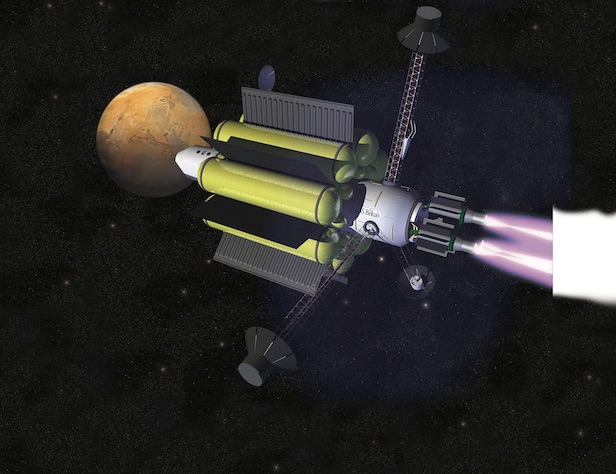Future Tech: Variable Specific Impulse Magnetoplasma Rocket
With radio waves contributing to fuel, VASIMR can make the journey to Mars in just 39 days

High-speed VASIMRs would be nuclear powered, to provide high-thrust rapid trips for human transport.
Impressive as traditional chemical rockets are, blasting majestically off their launch pads on columns of flame, they aren’t very good. They can provide significant thrust for a short time, but because the energy source (chemical reactions) is combined with the reactive mass, chemical spacecraft would have to be impractically large to achieve short journey times anywhere in the Solar System. If we are to explore the planets and establish permanent colonies beyond Earth we need alternative in-space propulsion capable of delivering much higher speed in a practical package. In development for over a decade by former astronaut Franklin Chang Diaz and his team, the VASIMR, or Variable Specific Impulse Magnetoplasma Rocket engine, might be what we need.
The most important attribute of a rocket system is Specific Impulse, or Isp, which is the amount of thrust you get per quantity of propellant burned. It is a measure of the efficiency of a rocket engine – confusingly it is measured in seconds, though it is not a time – and the bigger the value the better the rocket. The first large rocket engine, used in the German V2, had an Isp of 203 seconds whilst the Space Shuttle Main Engine ranged between 366 seconds at sea level and 452 seconds in space. These chemical engines can be used for launching into space and sending spacecraft on burn and coast missions to the planets; but there is an alternative: electric thrusters. These ionise a gas – separating electrons from their atoms to form an electrically conductive gas called a plasma – and then use electric or magnetic fields to accelerate them out of a nozzle. These ion engines can produce high specific impulses for long periods by accelerating a very small amount of propellant to a very high speed. However, they only produce very small thrusts. What is needed is a system that could combine the high thrust of chemical engines with the high specific impulse of ion engines.
VASIMR takes a similar approach to ion engines in that a gas is separately heated and accelerated, but avoids some of their drawbacks enabling high thrusts. First a gas like Argon or Xenon is injected into the engine through a tubular radio antenna called a helicon coupler, where it is ionised by radio waves, whilst electromagnets keep the plasma away from the walls of the chamber. Next the plasma passes through a superconducting magnet that squeezes the plasma while a second antenna pumps in more radio waves. This increases the temperature of the compressed plasma to 10 million degrees Celsius (18 million degrees Fahrenheit) before it is finally released through a diverging magnetic nozzle. By varying the propellant flow rate and the power delivered to the different stages of the engine VASIMR can produce relatively high thrust/low Isp performance for in-space boost, and low thrust/high Isp performance for long duration cruise. We’re still looking at ‘high’ thrust in the region of only five kilograms, but in space, and paired with an Isp of 3,000 seconds that would be very useful indeed. A solar-powered VASIMR tug could deliver cargo to the Moon for a sixth the propellant required by a chemical spacecraft, cutting the cost and making Solar System settlement more viable. The inspirational side is, of course, the ability to speed up human trips to the planets – if paired with a 200MW nuclear reactor a VASIMR transporter could make the trip to Mars in only 39 days.
Keep up to date with the latest news in All About Space – available every month for just £4.99. Alternatively you can subscribe here for a fraction of the price!




